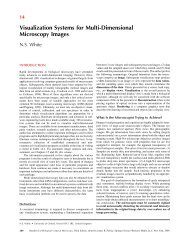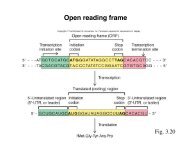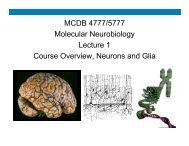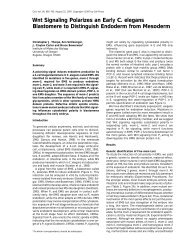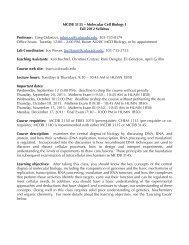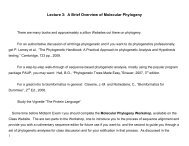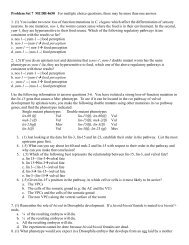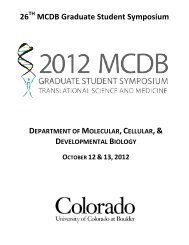ANSWERS to practice questions for quiz 1 1. Only coding DNA is ...
ANSWERS to practice questions for quiz 1 1. Only coding DNA is ...
ANSWERS to practice questions for quiz 1 1. Only coding DNA is ...
Create successful ePaper yourself
Turn your PDF publications into a flip-book with our unique Google optimized e-Paper software.
7. Convergent extension <strong>is</strong> an important type of movement during morphogenes<strong>is</strong>.<br />
Briefly explain how th<strong>is</strong> type of cell rearrangement might be important <strong>for</strong> a developing<br />
embryo. Convergent extension <strong>is</strong> particularly important <strong>for</strong> the spread of no<strong>to</strong>chord<br />
cells, as they have <strong>to</strong> extend a long ways from the dorsal blas<strong>to</strong>pore lip all the way up <strong>to</strong><br />
the future head. Basically, any time you need a chunk of cells <strong>to</strong> line up in a long orderly<br />
row, convergent extension <strong>is</strong> the way <strong>to</strong> go.<br />
8. You decide <strong>to</strong> investigate whether some known signaling pathways might be involved<br />
in determining ventral vs. dorsal mesoderm fate in Xenopus. You use antibody labeling<br />
<strong>to</strong> observe the localization of two different signaling ligands, Shh and a TGFβ family<br />
member (BMP4), in the early blastula stage. There are many different possibilities <strong>for</strong><br />
how these two ligands might be localized within the embryo. A. Predict their localization<br />
if mesoderm <strong>for</strong>ms due <strong>to</strong> a morphogen gradient or gradients. B. Predict their<br />
localization if two different kinds of mesoderm require different signals <strong>to</strong> be specified<br />
îf they act as a morphogen, each molecule must be present in a gradient across the<br />
embryo, and specify fate dependent on concentration. Thus, in th<strong>is</strong> case, you might see<br />
Shh gradient from low on the ventral side <strong>to</strong> high on the dorsal side, and BMP from high<br />
on the ventral side <strong>to</strong> low on the dorsal side.<br />
9.The polypeptide hormone prolactin stimulates milk production in female mammary<br />
glands. When the hormone <strong>is</strong> present, production of the milk protein casein increases,<br />
largely because the casein mRNA degrades much more slowly than it does when<br />
prolactin <strong>is</strong> absent. The hormone does not enter the mammary gland cells, and the<br />
degradation rates of other mRNAs are not affected. From your knowledge of signaling,<br />
predict the steps in a pathway by which the hormone could cause an increase in the<br />
stability of th<strong>is</strong> specific mRNA.<br />
Prolactin could<br />
<strong>1.</strong> act directly as a transcription fac<strong>to</strong>r (some steroid hormones can be transported<br />
directly <strong>to</strong> the nucleus –“nuclear hormone recep<strong>to</strong>rs”) <strong>to</strong> trigger casein<br />
production (prolactin doesn’t actually work th<strong>is</strong> way, but it <strong>is</strong> a reasonable<br />
hypothes<strong>is</strong>)<br />
2. act as signaling ligand (bind <strong>to</strong> a recep<strong>to</strong>r) and through signaling cascade,<br />
activate transcription of casein<br />
3. prevent degradation of casein by binding <strong>to</strong> whatever normally degrades It after it<br />
has been translated<br />
4. activate transcription of another fac<strong>to</strong>r which could bind <strong>to</strong> the 3’UTR of the<br />
casein mRNA, allowing it <strong>to</strong> stick around longer and thus produce more protein.




